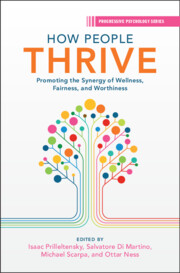Book contents
- How People Thrive
- The Progressive Psychology Book Series
- How People Thrive
- Copyright page
- Contents
- Figures
- Tables
- Contributors
- Chapter 1 Thriving as the Synergy of Wellness, Fairness, and Worthiness
- Chapter 2 Thriving within Ourselves: Epistemic Injustice and Individual Wellness
- Chapter 3 Thriving Families and Friendships
- Chapter 4 Thriving in Context: Wellness, Fairness, and Worthiness in Diverse Groups
- Chapter 5 Thriving Schools: Creating Equitable Thriving within Schools
- Chapter 6 Thriving Workplaces: Wellness, Fairness, and Worthiness at Work
- Chapter 7 Thriving Communities
- Chapter 8 Thriving Societies
- Chapter 9 Thriving World
- Index
- References
Chapter 7 - Thriving Communities
Published online by Cambridge University Press: 14 November 2024
- How People Thrive
- The Progressive Psychology Book Series
- How People Thrive
- Copyright page
- Contents
- Figures
- Tables
- Contributors
- Chapter 1 Thriving as the Synergy of Wellness, Fairness, and Worthiness
- Chapter 2 Thriving within Ourselves: Epistemic Injustice and Individual Wellness
- Chapter 3 Thriving Families and Friendships
- Chapter 4 Thriving in Context: Wellness, Fairness, and Worthiness in Diverse Groups
- Chapter 5 Thriving Schools: Creating Equitable Thriving within Schools
- Chapter 6 Thriving Workplaces: Wellness, Fairness, and Worthiness at Work
- Chapter 7 Thriving Communities
- Chapter 8 Thriving Societies
- Chapter 9 Thriving World
- Index
- References
Summary
Though it is derived from individual thriving, community thriving cannot be reduced to the aggregate of individual experiences. Rather, community thriving is defined as the function of a community’s sustainability and its effectiveness at producing well-being outcomes. An overview of community concepts related to thriving, thus defined, is offered, and the implications of well-being, fairness, and worthiness in a community context are detailed. The chapter concludes with specific historical illustrations and steps readers can take to enhance the thriving of their own communities.
- Type
- Chapter
- Information
- How People ThrivePromoting the Synergy of Wellness, Fairness, and Worthiness, pp. 203 - 233Publisher: Cambridge University PressPrint publication year: 2024

